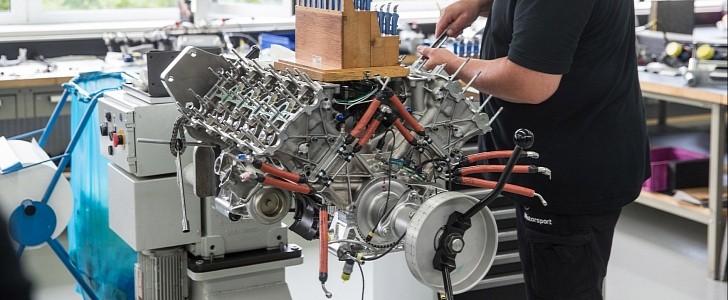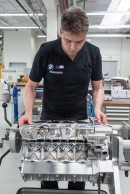BMW will take its LMDh prototype racer to the Le Mans 24 Hours in 2024, on the 25th anniversary of the Munich-based automaker’s victory with the V12 LMR. Be that as it may, the Bavarian outfit is currently preparing its new racecar for the 2023 IMSA WeatherTech SportsCar Championship.
In the build-up to the testing phase of the M Hybrid V8, the German company is much obliged to present the P66/3 engine of the LMDh prototype racing car. The 4.0-liter V8 features a cast-aluminum cylinder block and cylinder heads, cast-iron cylinder liners, and a 90-degree angle between the cylinder banks. Gifted with a 93-millimeter (3.66 inch) bore and 73.6-millimeter (2.89 inch) stroke, the twin-turbocharged engine can take up to 8,200 revolutions per minute.
Fitted with a direct-injection system that operates at 350 bar, which is 5,076 psi for those who prefer the imperial system, this lump develops in the ballpark of 640 horsepower and 650 Nm (479 pound-feet). The output is obviously regulated. Dry-sump lubrication with a six-cell oil drain pump also needs to be highlighted, along with a four-valve-per-cylinder setup.
“During the evaluation phase, we took a look at the P48 four-cylinder turbo engine and P63 eight-cylinder turbo engine,” said Ulrich Schulz, head of drivetrain design at BMW M Motorsport. “Potential problems with the durability of the P48 and the heavy weight of the P63 were negative considerations,” which perfectly explains why the P66/1 from the 2017 and 2018 BMW M4 DTM served as the basis for the much-improved P66/3.
“Converting the normally-aspirated P66/1 into a bi-turbo and then working with the electric drivetrain colleagues to turn it into a hybrid drive system was very complex. We managed to complete the fire-up of the complete drive unit just a few weeks ago. We now feel that nothing is standing in the way of testing,” signed off the head of drivetrain design at BMW M Motorsport.
What happened to P66/2? The Bavarian automaker explains that P66/1 was first converted into P66/2, an intermediate powerplant. BMW’s primary focus for the P66/2 was durability, performance, and temperature management. After numerous tests, this engine was adapted into the P66/3 with all the specific requirements of the M Hybrid V8 racecar’s Dallara chassis.
The combustion engine and hybrid bits were connected in the car for the first time at the end of June. The initial shakedown for the M Hybrid V8 is scheduled for late July at Autodromo di Varano de Melegari in Italy.
Fitted with a direct-injection system that operates at 350 bar, which is 5,076 psi for those who prefer the imperial system, this lump develops in the ballpark of 640 horsepower and 650 Nm (479 pound-feet). The output is obviously regulated. Dry-sump lubrication with a six-cell oil drain pump also needs to be highlighted, along with a four-valve-per-cylinder setup.
“During the evaluation phase, we took a look at the P48 four-cylinder turbo engine and P63 eight-cylinder turbo engine,” said Ulrich Schulz, head of drivetrain design at BMW M Motorsport. “Potential problems with the durability of the P48 and the heavy weight of the P63 were negative considerations,” which perfectly explains why the P66/1 from the 2017 and 2018 BMW M4 DTM served as the basis for the much-improved P66/3.
“Converting the normally-aspirated P66/1 into a bi-turbo and then working with the electric drivetrain colleagues to turn it into a hybrid drive system was very complex. We managed to complete the fire-up of the complete drive unit just a few weeks ago. We now feel that nothing is standing in the way of testing,” signed off the head of drivetrain design at BMW M Motorsport.
What happened to P66/2? The Bavarian automaker explains that P66/1 was first converted into P66/2, an intermediate powerplant. BMW’s primary focus for the P66/2 was durability, performance, and temperature management. After numerous tests, this engine was adapted into the P66/3 with all the specific requirements of the M Hybrid V8 racecar’s Dallara chassis.
The combustion engine and hybrid bits were connected in the car for the first time at the end of June. The initial shakedown for the M Hybrid V8 is scheduled for late July at Autodromo di Varano de Melegari in Italy.
















